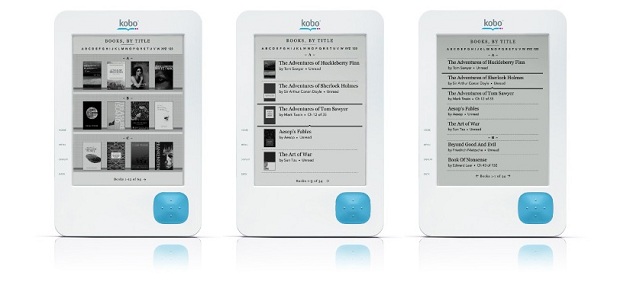In light of the coming arrival of Apple’s magic tablet, you might wonder what reason anyone would have left for an eReader. It’s tough to imagine anyone preferring their dull, greyscale screens – that Nicholas Baker once called a “four-by-five window onto an overcast afternoon” – to the glossy LCD of an iPad.
After all, when you think of the comparisons between them, it isn’t just the screen that makes the iPad looks so impressive next to an Amazon Kindle or Sony Reader. The iPad is obviously full-color and is capable of not only showing video but playing music too. It surfs the web, it downloads apps, it plays games. So why would you want an eReader?
Well, the announcement of the $150 Kobo eReader gives some clue as to why, rather than killing eReaders, the iPad will likely exist side-by-side with them – and here’s why that’s a good thing.
One of the great benefits of the digital age has been that buying one device allows you to do multiple things. Get an iPhone and you not only have a cell phone, but an iPod and a calculator and organizer and web device too. This has been a boon to individuals and society as a whole: people do more in less time and with less effort.
Trouble is, the multi-functionality of devices also lends itself to multi-tasking in quick, short bursts. To those of us who spend our lives in front of a computer all day, this just seems normal. But to people who like to read – and there are still a lot of them – this flitting between tasks is exactly the kind of things they don’t want.
Nobody wants to read a novel in bursts of 5 pages spread out over weeks. The pleasure of reading is precisely the opposite of multi-tasking where you enjoy slipping into your imagination undisturbed for a couple of hours – something Sven Birkerts calls the creation of ‘an interior world’.
By having a single-function device, eReaders give you the convenience of digital – you know, carrying hundreds of books in your pocket at once – without the downside of a decreased attention span. While tech-geeks look at an eReader as strangely limited, readers look at the fact that they only do one thing with a sense of relief. “Finally!”, they think. “Digital convenience without distraction!”
But more to the point is the issue of accessibility. When you take society as a whole, how many people do you think are going to be able to afford a $5oo device just to surf the web and read books and magazines?
Reading as an activity has, at various times in history, in various places, been an activity for the wealthy. For a long time this was because the wealthy were the only ones who could afford either books themselves or the time to read them – a phenomenon that still exists in many places around the world.
But the cheap trade paperback changed all of that, and while demographics still tend to skew toward those with more cash than not, reading is something that is now available to the mainstream of society.
Do we really want reading to shift to devices that cost $500 at a minimum? Or that require a paid Wi-Fi or 3G connection to be used to their maximum capacities? Isn’t that pushing reading in exactly the wrong direction?
If we’re concerned with decreasing literacy rates and attention spans, the best path is to keep technology simple, single-function and cheap. If, in 2010, Kobo can launch an eReader for $149, it isn’t inconceivable that in 2015, one might launch for $40 or $50. Throw in a couple of hundred public domain books and that’s a deal even a parent on a tight budget would consider.
Sure, all hail the iPad. As tech geeks, we’re looking forward to it and other similar tablet devices for good reason. But let’s not forget that reading is something for everyone. And until you can get an iPad as a free gift in a cereal box, there’s one way to keep more people reading and keep them focused doing it: make cheap eInk eReaders.




